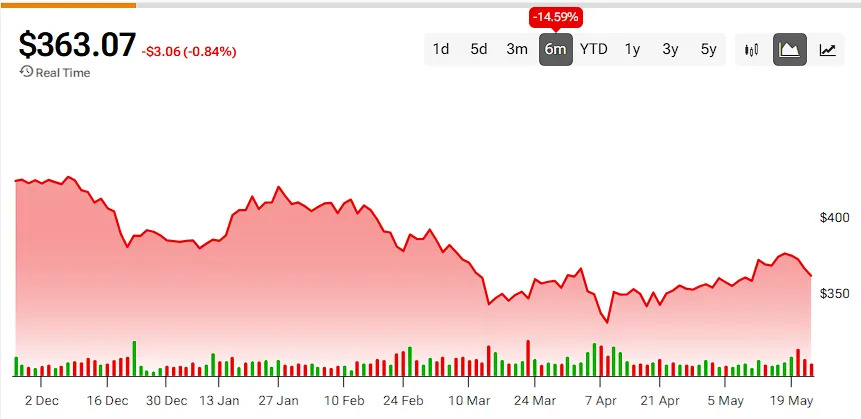Home Depot (HD) stock has been under a cloud lately, with last week’s earnings report laying bare some tough challenges . The home improvement giant faces headwinds like tariff pressures, a sluggish housing market, and rising financing costs, which have dulled its shine. With sales growth slowing and earnings forecasts underwhelming, the stock will likely remain under pressure, especially given that Home Depot’s valuation isn’t particularly attractive. As a result, I am leaning bearish on HD stock.
Confident Investing Starts Here:
Tariffs: A Costly Curveball
Tariffs are hitting Home Depot hard, especially with nearly half its sales tied to imported goods. The U.S. recently adjusted tariffs on Chinese imports to 30% and slapped a 10% duty on other countries, which, while a short-term breather, continues to mess with orders and pricing. CFO Richard McPhail emphasized during the Q1 earnings call that Home Depot won’t raise prices to offset these costs, choosing instead to absorb them or tweak its product lineup. This strategy will protect customers, but it will also squeeze margins, which already took a 40-basis-point hit in Q, partly due to tariffs. With trade policies still in flux, this pressure will not likely ease soon.
Fortunately, the company’s diversified supply chain and strong pro business (50% of sales) give it some wiggle room compared to rivals like Lowe’s, which relies more on Chinese imports. However, absorbing a blended tariff cost on goods in the mid-single-digits isn’t trivial. If trade tensions heat up, Home Depot could be forced to ditch its no-price-increase policy, which might tick off customers or squeeze profits even more. For now, tariffs are a persistent pain in the neck.
Housing Market Blues
In the meantime, the housing market is in a funk, and Home Depot is naturally feeling the pinch. High mortgage rates, now hovering close to 7%, have frozen homebuyers, slowing turnover and big-ticket renovation projects. Evidently, even though Q1 sales reached $39.86 billion, up 9.4% year-over-year, comparable sales dipped 0.3%, signaling weaker demand for major projects. Customers are sticking to smaller jobs, like spring gardening, which boosted transactions by 2.1% but didn’t move the needle on average ticket size.
I believe squeezed consumer spending power and high rates will suppress demand for pricey remodels. Indeed, Home Depot’s guidance assumes this trend lasts, with management noting “continued pressure on larger projects” in the earnings call. With no clear catalyst like falling rates or a housing rebound on the horizon, this headwind could linger into late 2025, keeping sales growth muted.
Rising Financing Costs Sting
Higher financing costs are another hurdle. After Moody’s downgraded the U.S. credit rating to AA1, 10-year and 30-year Treasury yields climbed, pushing up borrowing costs for home improvement projects. This hits Home Depot’s core customers (both DIYers and pros) who often finance large purchases. The latest report didn’t directly tie this to performance, but management acknowledged the broader impact of higher yields on consumer behavior.
Overall, the current environment discourages splurging on appliances or major renovations, as seen in flat average ticket sizes. It’s also worth noting that Home Depot’s acquisition of SRS Distribution, which serves pros, added sales but also drove a 15-basis-point margin drag, partly due to financing sensitivity in that segment. With yields likely to stay high, this is another headwind that could keep weighing on demand, especially if economic uncertainty persists.
A Pricey Stock in a Tough Spot
Despite these challenges and notable pressure lately, Home Depot stock still trades at a lofty 24x this year’s expected EPS of ~$15. This feels steep for a company staring down flat EPS growth in 2025. And yes, Home Depot’s a quality name, with a rock-solid pro business and decades-long track record of successful execution, but a premium valuation paired with lackluster growth is a tough sell.
Today’s valuation essentially assumes a recovery that’s not guaranteed soon. Consensus estimates point to a 0.6% EPS growth for FY2026 , and management’s cautious tone on the Q1 call, including stressing tariff and housing pressures, doesn’t inspire confidence. So while Home Depot’s brand and scale deserve some premium, the gap between its price and growth prospects could keep sentiment sour, especially if headwinds persist.
Is Home Depot Stock a Good Buy Right Now?
Despite the fog surrounding Home Depot’s investment case, Wall Street analysts seem somewhat bullish. Specifically, HD stock features a Strong Buy consensus rating based on 20 Buys, six Holds, and zero Sell recommendations over the past three months. At $428.74, the average HD stock price target implies an upside potential of ~18% from current levels.
Caution Is Warranted on Home Depot
Home Depot’s recent stock decline may attract value-oriented investors, but the path forward appears challenging. Persistent headwinds—including tariffs, a sluggish housing market, and rising financing costs—remain firmly in place, as reflected in the company’s latest earnings report.
With limited growth prospects and a valuation of 24x earnings, the stock currently seems more like a potential value trap than a bargain. For long-term investors, it may be prudent to wait for clearer signs of recovery, such as easing trade pressures or declining interest rates, before considering an entry point.
Disclaimer & Disclosure Report an Issue


